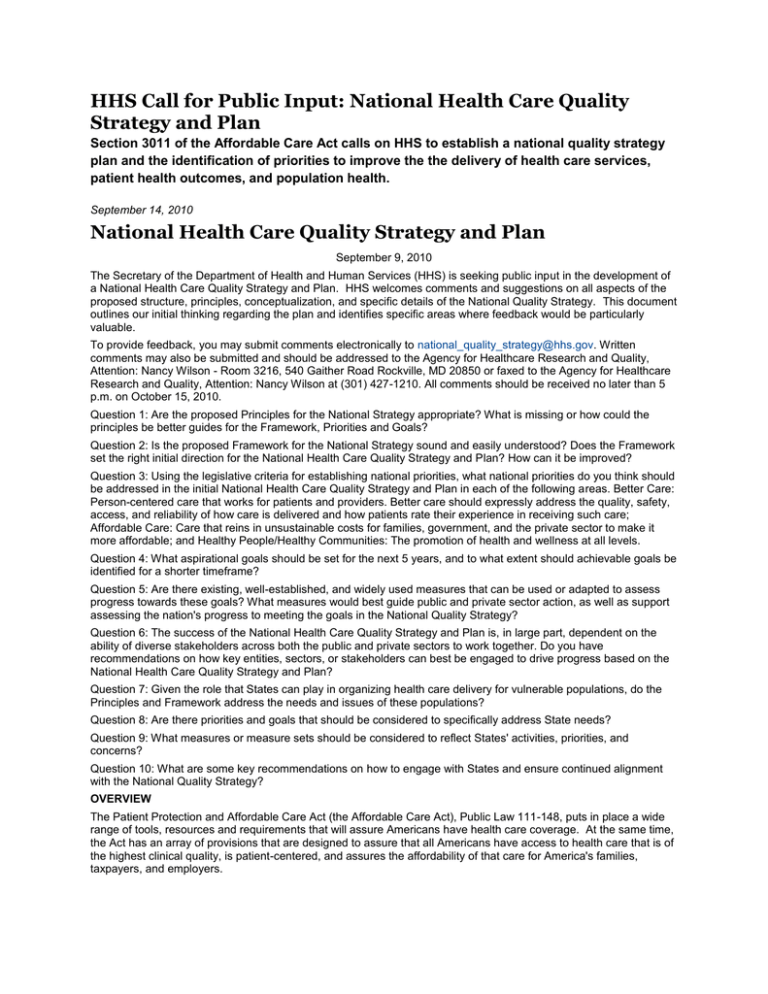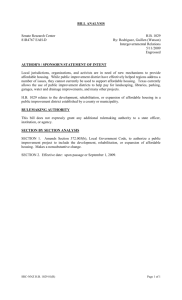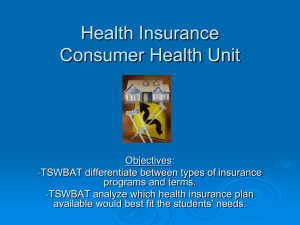HHS Call for Public Input: National Health Care Quality Strategy and
advertisement

HHS Call for Public Input: National Health Care Quality Strategy and Plan Section 3011 of the Affordable Care Act calls on HHS to establish a national quality strategy plan and the identification of priorities to improve the the delivery of health care services, patient health outcomes, and population health. September 14, 2010 National Health Care Quality Strategy and Plan September 9, 2010 The Secretary of the Department of Health and Human Services (HHS) is seeking public input in the development of a National Health Care Quality Strategy and Plan. HHS welcomes comments and suggestions on all aspects of the proposed structure, principles, conceptualization, and specific details of the National Quality Strategy. This document outlines our initial thinking regarding the plan and identifies specific areas where feedback would be particularly valuable. To provide feedback, you may submit comments electronically to national_quality_strategy@hhs.gov. Written comments may also be submitted and should be addressed to the Agency for Healthcare Research and Quality, Attention: Nancy Wilson - Room 3216, 540 Gaither Road Rockville, MD 20850 or faxed to the Agency for Healthcare Research and Quality, Attention: Nancy Wilson at (301) 427-1210. All comments should be received no later than 5 p.m. on October 15, 2010. Question 1: Are the proposed Principles for the National Strategy appropriate? What is missing or how could the principles be better guides for the Framework, Priorities and Goals? Question 2: Is the proposed Framework for the National Strategy sound and easily understood? Does the Framework set the right initial direction for the National Health Care Quality Strategy and Plan? How can it be improved? Question 3: Using the legislative criteria for establishing national priorities, what national priorities do you think should be addressed in the initial National Health Care Quality Strategy and Plan in each of the following areas. Better Care: Person-centered care that works for patients and providers. Better care should expressly address the quality, safety, access, and reliability of how care is delivered and how patients rate their experience in receiving such care; Affordable Care: Care that reins in unsustainable costs for families, government, and the private sector to make it more affordable; and Healthy People/Healthy Communities: The promotion of health and wellness at all levels. Question 4: What aspirational goals should be set for the next 5 years, and to what extent should achievable goals be identified for a shorter timeframe? Question 5: Are there existing, well-established, and widely used measures that can be used or adapted to assess progress towards these goals? What measures would best guide public and private sector action, as well as support assessing the nation's progress to meeting the goals in the National Quality Strategy? Question 6: The success of the National Health Care Quality Strategy and Plan is, in large part, dependent on the ability of diverse stakeholders across both the public and private sectors to work together. Do you have recommendations on how key entities, sectors, or stakeholders can best be engaged to drive progress based on the National Health Care Quality Strategy and Plan? Question 7: Given the role that States can play in organizing health care delivery for vulnerable populations, do the Principles and Framework address the needs and issues of these populations? Question 8: Are there priorities and goals that should be considered to specifically address State needs? Question 9: What measures or measure sets should be considered to reflect States' activities, priorities, and concerns? Question 10: What are some key recommendations on how to engage with States and ensure continued alignment with the National Quality Strategy? OVERVIEW The Patient Protection and Affordable Care Act (the Affordable Care Act), Public Law 111-148, puts in place a wide range of tools, resources and requirements that will assure Americans have health care coverage. At the same time, the Act has an array of provisions that are designed to assure that all Americans have access to health care that is of the highest clinical quality, is patient-centered, and assures the affordability of that care for America's families, taxpayers, and employers. Context: Multiple provisions of the Affordable Care Act build on and expand existing programs that assess and improve quality of care. These include programs for hospitals, physicians, nursing homes, and other providers that link public reporting on selected dimensions of quality with Medicare reimbursement. The Affordable Care Act builds on these efforts to expand the linkage between payment and results - what is often called value-based purchasing to reach doctors, hospitals and virtually all sites of care. In addition to these programs, the Affordable Care Act includes requirements for new programs led by the Center for Medicare & Medicaid Services (CMS) that will expand payments for primary care, as well as promote better care coordination, integration of services and patient-focused care, such as through accountable care organizations and advanced primary care practices (also known as "medical homes"). A new Center for Medicare and Medicaid Innovations will assure that promising innovations in care delivery and payment are well tested and then expanded into future policies for all providers. Among the many other provisions of the Affordable Care Act that will support the delivery of better care are provisions that support doctors in improving the care they deliver, expanding the workforce to meet needs for more primary care clinicians, development of curricula for health care professionals in training and the establishment of an independent PatientCentered Outcomes Research Institute to evaluate what works and provide better information for patients and their doctors. The Affordable Care Act builds on earlier enacted legislation, notably the Children's Health Insurance Program Reauthorization Act (CHIPRA) and the American Recovery and Reinvestment Act (ARRA). CHIPRA includes provisions to support quality assessment and improvement for children insured by the Medicaid and CHIP programs. In addition, under ARRA there are substantial incentives for doctors and hospitals to adopt electronic health records to improve care quality and safety. HHS has also instituted other initiatives as part of the Administration's focus on the prevention and elimination of health care-associated conditions (such as pressure ulcers or hospital-acquired infections) and improved care for individuals with multiple chronic illnesses. With the Affordable Care Act, Medicare and other public programs will expand their leadership and help pave the way for improving health care for all Americans. At the same time, the Administration recognizes that improving the quality and affordability of health care is an enterprise that requires strong collaborations between the Federal government, States, and the private sector. Both for the programs already implemented and as it plans for the future, the federal government is looking to align its efforts with states and the private sector and get input from multiple stakeholders on all aspects of the effort to foster higher quality, more affordable care. The fact that there is an array of federal and private sector efforts underway or are being initiated to improve health care has led to an element of the Affordable Care Act that seeks to integrate these efforts into a cohesive plan. Section 3011 of the Affordable Care Act calls on the Secretary of the Department of Health and Human Services (HHS) to establish a national quality strategy, including a comprehensive strategic plan and the identification of priorities to improve the delivery of health care services, patient health outcomes, and population health. The Affordable Care Act requires that the strategy be developed in a transparent and collaborative process and also calls for a parallel National Prevention and Health Promotion Strategy that is scheduled to be released in March of 2011. The initial Health Care Quality Strategy and Plan is due to Congress by January 1, 2011 and must include provisions for: 1) agency-specific plans and benchmarks; 2) coordination among agencies; 3) strategies to align public and private payers; and 4) alignment with meaningful use of health information technology (IT). The National Health Care Quality Strategy and Plan (the "National Quality Strategy") is intended to be a living and changing guide for the Federal government, as well as for States and the private sector. The hope is that the National Quality Strategy will be sustainable over time, and support priorities and associated goals that will be periodically updated and refined to accommodate emerging issues. Updates on progress towards meeting the goals and priorities will be reported annually to Congress and the American public. The Affordable Care Act also calls for the development of a National Prevention and Health Promotion Strategy (the "National Prevention Strategy") that is scheduled to be released in March of 2011. The National Prevention Strategy will take a community approach to implement prevention efforts that will reduce the incidence of the leading causes of death and disability. Both the National Quality Strategy and the National Prevention Strategy seek to generate, align, and focus collaboration among public and private sector partners. The National Prevention Strategy will also be developed by consultation across the federal government. The two strategies will share common goals and priorities for healthy people and communities. Both will include an explicit focus on goals that require close collaboration between clinical and community partners. Ensuring that the National Quality Strategy is effective will require a strong private/public partnership based on a shared commitment to ensuring that Americans receive consistent, high-quality, safe, and affordable care. The National Quality Strategy will build on a growing recognition of the opportunity to make dramatic improvements in quality and safety, interest among Americans in working with their doctors and other clinicians to get the best care for their needs, and increased understanding that as a nation we must address health care's rising costs to make it affordable. There is a strong foundation of work led by federal, state and private sector quality initiatives that have identified both challenges and opportunities to improve our nation's health care. These strategic efforts and initiatives include but are not limited to those identified in Table 1. Table 1. Sample Public and Private Strategic Initiatives and Frameworks Institute of Medicine's "Crossing National Commission on Workforce the Quality Chasm's Quality Development Framework" Legislatively mandated quality and National Priority Partnership's payment programs to foster better care "National Priorities and Goals" for Medicare beneficiaries (including HHS Healthy People 2020 programs for Medicare Advantage AHRQ National Healthcare Quality health plans, hospitals, clinicians and Report & National Healthcare other providers) Disparities Report Meaningful use of health IT White House Let's Move Initiative National, regional and State-based White House National HIV/AIDS initiatives Strategy THE NATIONAL HEALTH CARE QUALITY STRATEGY AND PLAN What follows are some of the initial principles to guide the National Health Care Quality Strategy and Plan that build on many other strategic planning efforts. These principles, in turn, are intended to guide the broad framework of our effort to engage state and diverse private-sector stakeholders in shaping this National Strategy. Our hope is that a guiding framework will provide a vision that focuses the work of major strategic efforts and initiatives on a small set of core principles and goals that represent our highest priorities and are aspirational, actionable, and aligned across the nation. Principles Guiding the National Quality Strategy The initial set of potential "core principles" are intended to serve as the underpinning of the National Quality Strategy and should be reflected not only in the framework, but in how goals, targets, and plans are developed. They include: Person-centeredness and family engagement will guide all strategies, goals, and improvement efforts The strategy and goals will address all ages, populations, service locations, and sources of coverage Eliminating disparities in care - including but not limited to those based on race, ethnicity, gender, age, disability, socioeconomic status and geography - will be integral to all strategies and goals The design and implementation of the strategy will consistently seek to align the efforts of public and private sectors






